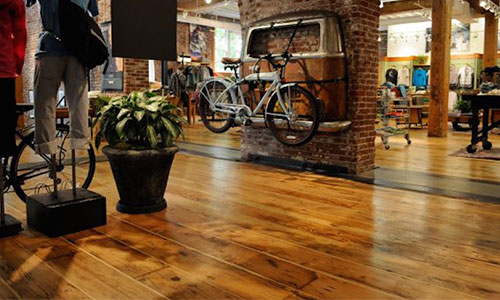There are numerous design considerations for commercial spaces. In addition to many industry-specific requirements, commercial spaces need to cope with heavy traffic and create a comfortable and safe environment for employees and visitors. As such, the demands on commercial flooring are very different to those in a private home! Today we look at 10 considerations for commercial flooring that help create a functional, comfortable, and beautifully designed space.
1. Look for flooring that sets a mood for the space – Traditional commercial flooring has been prone to generic beiges and greys,, where the most neutral possible option is chosen, however more and more innovative designers are now treating the floor as an integral part of the design concept. By choosing carpet tiles, a modular style of flooring, you can design a space that is unique, as well as precisely tailored to mood, colour and taste.
2. Look for durability – Durability is obviously a prime consideration in commercial flooring. Heavy traffic is usually encountered, and flooring must be resistant to damage as well as general wear. Look for carpet tiles with a dense loop pile construction which can be incorporated with using hardwood for commercial flooring. Hardwood is not as durable as you might think!
3. Look for underfoot comfort- If a space is commercial, it means people are working in it. This means that employee safety and comfort is one of the prime considerations in choosing flooring, and the best option for underfoot comfort is soft flooring. Carpet and carpet tiles can considerably reduce leg, foot and back fatigue and lead to greater productivity and fewer lost work hours.
4. Look for noise reduction – Commercial spaces have the potential to become very noisy. Soft flooring helps absorb the noise which can become almost overwhelming in busy periods.
5. Look for flooring that improves air quality- It is a popular misconception that hard flooring is better for asthmatics, allergy sufferers, and for general air quality. Many believe that hard flooring reduces the number of fibres floating around in the air, when in fact it increases them. Carpets and carpet tiles trap dust, pollen and other allergens in their fibres as soon as the airborne particles settle, until they can be safely removed by cleaning with a HEPA-filtered vacuum cleaner. Hard flooring leaves the particles free to be stirred up by somebody walking by, irritating employees and guests.
6. Look for flooring that is easy to replace – All flooring is subject to stresses. The difference between a truly cost-effective flooring type and one with a high lifetime cost is ease of replacement. Heavily worn or stained carpet tiles can be lifted and replaced with no specialist help, and at very low cost.
7. Look for flooring that protects against germs – Some innovative carpet tile manufacturers have begun incorporating antimicrobial protectants into their products. This protection actually lasts for the life if the product – there is nothing to be renewed or re-bought.
8. Look for flooring that doesn’t produce excess waste – On average, 10% of broadloom carpet purchased is wasted on installation, because the broad rolls must be cut to shape. The wastage for modular carpet tiles is only 3-4%.
9. Look for flooring that is sustainable – Hardwood flooring can be made from bamboo or sustainably grown timbers – but obviously doesn’t meet many of the other best-practice requirements listed. Some carpet tiles come with a GECA certification – a great selling point for your customers.

Recent Comments